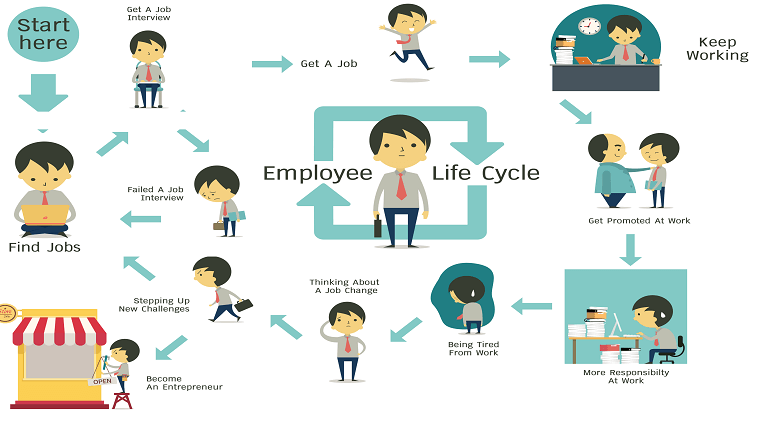“A life is a full circle,” says a beautiful adage. “The end of one trip heralds the start of the next.” This saying signifies the employee life cycle which is the employee’s overall experience with the company right from hire to retire. The employee life cycle is a trajectory where employees progress through several stages in an organization and HR’s contrivance in optimizing that growth creating experiences.
By concentrating on the employee life cycle and mapping the employee journey, employers can not only recruit the talent they need to succeed in today’s markets, but also provide a more sustainable customer experience.
The assessment of the employee life cycle is important for any organization as this model is used to identify and communicate the many and most essential stages that an employee experiences as they interact with their employer. It gives employees a consistent set of processes to follow throughout their career with the company and allows managers to assess data.
Stages of the Employee Life cycle that helps in evaluating the growth of an employee aligned with the organizational growth.
-
Stage One: Apply the Law of Attraction
The employer must promote the company’s brand image, values, and opportunities so that prospects can get a sense of what it feels like to work for that company and whether their needs connect with what the company offers.
-
Stage Two: Recruit the Best Fit
The appropriate recruitment approach represents the company’s professionalism and demonstrates the organization’s maturity when it comes to employing the best people. An effective method helps in the proactive establishment of a talent pool, assisting in the achievement of medium- and long-term corporate objectives.
-
Stage Three: Onboard Candidates to Align their goals with the company goals
The process of integrating a new employee into a company’s culture and providing them with the tools and information they need to become a productive member of the team is known as employee onboarding.
-
Stage Four: Retention holds the talent
Employee retention plans must include aspects such as work satisfaction and engagement. Employers typically want to reduce employee turnover to save money on training, recruitment, and the loss of talent and organizational expertise.
-
Stage Five: Employee Development
An employee development program encapsulates a defined process in which an employee, with the help of his or her company, participates in various training programs to improve his or her abilities and learn new things.
-
Stage Six: Exit Formalities
When a company offboards an employee, the policies and processes that are followed are referred to as the employee exit process.
-
Stage Seven: Alumni
An alumnus is a former employee who shares in the company’s culture and impression of the outer world. Alumni could influence the customer for the association. Past employees may return to work, work for a customer, or be asked for their opinion on their company by potential applicants in the future.
How to Map the Employee Life Cycle Stages
Employers are advised not to wait until problems arise. They must be proactive and use an employee experience journey map to improve their employee experience. Employee journey mapping is a method of charting the important stages and experiences of an employee’s career path.
To graphically document and analyze each step of the employee experience, HR must create a chronological chart. Based on the chart, HRs must discuss the various stages and their respective strengths and shortcomings. Employee experience journey mapping(1)can be used by HR teams and company leaders to improve the employee experience.
In a recent poll, more than half of employees indicated they are disengaged from their jobs, which indicates they are unhappy at work and are communicating their dissatisfaction to their co-workers. An improved experience can lead to improved retention rates, increased productivity, cheaper recruiting expenses, and better customer service.
( Also Read: Optimize the Employee Life Cycle Through HR Technology )
Identify the Areas of Improvement During the Employee Journey
A well-designed map can assist HRs in identifying areas for improvement and enhance employee satisfaction. The aim of measuring the employee experience is to keep them motivated and engaged. To get there, examine the company’s HR processes and initiatives and evaluate where improvements could be made.
Focusing on instances when employees have faced delays, bottlenecks, or inaccuracies is a wonderful approach to find areas for improvement also how an employer might adjust to bring about more positive outcomes is a great way to identify areas for improvement.
The following are some examples of potential challenges that constantly needs to be controlled:
- An employer does not have a clear view of the talent pipeline for certain open positions, and it takes longer to fill open positions than expected.
- After being hired, employees find a void in their onboarding, leaving them confused about how to get specific information or where to seek assistance.
- Benefits enrolment data does not match employee payroll deductions.
- Running accurate reports summarizing recruitment activities, headcount, or staff time off is difficult.
- Some employees are stuck in a channel and want assistance in rejuvenating their careers which they fail to avail themselves of.
KRAs And KPIs Techniques and Metrics to Measure Performance
KRA (Key Results Area) is an important aspect of performance management, and it is used to evaluate employees’ successes during the company’s performance management process.
KPIs (Key Performance Indicators) are HR measures that show how HR contributes to the rest of the company.
Key Performance Indicators, or KPIs, are a crucial aspect in determining the company’s successes and failures. A KPI, codenamed as a flash report or dashboard, allows business owners and managers to see how their company or specific departments are performing at any given time.
Employers may compare how the employee experience connects with (KPIs) using the quantitative data. This quantitative data encompasses acceptance rates, productivity, engagement, absences, and attrition. Based on the data and feedback the HRs receive, they make modifications.
One thing is certain, if businesses don’t track employee experience metrics, they will have no idea how they are performing. They won’t be able to assess their achievements. Putting together an employee experience dashboard is an efficient procedure that may yield business benefits for years when businesses use top-of-the-line human resources technology.
Implement HR Technology that Helps in Gauging, and Improving Employee Experience Metrics
Taking the effort to map out the employees’ journeys can help the firm provide a better employee experience. Employees become more engaged at work as the experience improves. Employees can become more productive as processes become more efficient.
All of these efforts can be supported by software that supports the employee experience and gives employers the tools needed to map out the employee journey, identify pain points, and make the necessary improvements.
Companies may automate and manage the employee lifecycle with HCM (Human Capital management) software, resulting in a more engaging employee experience. One of the advantages of HCM software is that it provides workers with self-service access to information such as benefits and compensation, as well as their employee profile ensuring a positive experience for both company and its employees.
Employees can use a simple interface to complete daily tasks such as requesting time off, applying for leave, and viewing an employee directory. Employee timelines assist the team in keeping track of important information like remuneration and training.
HCM software may also help HR keep track of KPIs such as the time it takes to train new employees, productivity, and turnover rates, as well as remain on top of new and leading practices. Human capital management (HCM) software platforms such as Kronos and MuleSoft provide an end-to-end employee lifecycle management solution.
Final Thought
An employee lifecycle model is a useful tool for visualizing and planning each stage of an employee’s interactions with the firm. The human capital resource (HCR) ecosystem includes technology that supports the whole employee lifecycle, from hiring to retirement. Data from each stage of the employee lifecycle can be merged with data from other stages’ platforms. It is possible to attract and retain a fantastic team by focusing on the employee needs and improving their experiences obtained from feedback.








